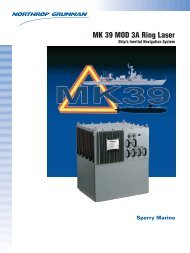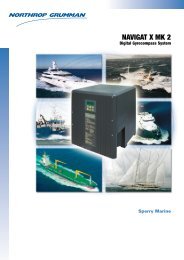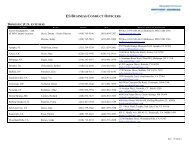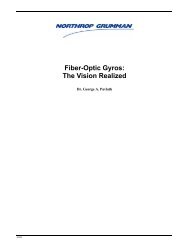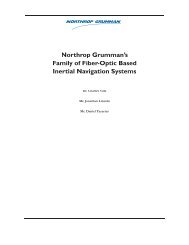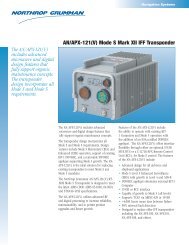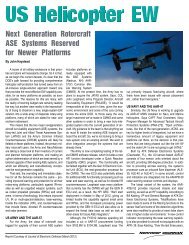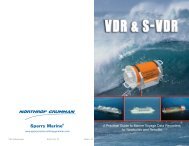AWACS Surveillance Radar -- The Eyes of the Eagle
AWACS Surveillance Radar -- The Eyes of the Eagle
AWACS Surveillance Radar -- The Eyes of the Eagle
You also want an ePaper? Increase the reach of your titles
YUMPU automatically turns print PDFs into web optimized ePapers that Google loves.
A Heritage <strong>of</strong> Leadership<br />
<strong>The</strong> E-3 Sentry is an Airborne Warning<br />
and Control System (<strong>AWACS</strong>) aircraft<br />
that provides all-wea<strong>the</strong>r surveillance,<br />
Command, Control and Communications<br />
needed by commanders <strong>of</strong> air tactical<br />
forces. Proven in wartime operations such<br />
as Desert Storm, Allied Force and more<br />
recently Enduring Freedom, as well as<br />
ongoing peacekeeping and humanitarian<br />
efforts, <strong>AWACS</strong> is <strong>the</strong> premier air battle<br />
command and control aircraft in <strong>the</strong><br />
world today.<br />
Northrop Grumman Electronic Systems<br />
(ES) has a long heritage in <strong>the</strong><br />
development and production <strong>of</strong> Airborne<br />
Early Warning (AEW) radars. As <strong>the</strong><br />
supplier to Boeing for <strong>the</strong> AN/APY-1 and<br />
AN/APY-2 radar systems used on <strong>the</strong> E-3,<br />
and <strong>the</strong> AN/APY-2 radar system used on<br />
<strong>the</strong> E-767, ES has continued as a leader in<br />
<strong>the</strong> development <strong>of</strong> radar technology for<br />
airborne applications.<br />
Mounted atop <strong>the</strong> aircraft fuselage in<br />
a rotating dome, <strong>the</strong> <strong>AWACS</strong> S-band<br />
(E-F band) surveillance radar is able to<br />
survey, in 10-second intervals, a volume <strong>of</strong><br />
airspace covering more than 200,000<br />
square miles (500,000 square km) around<br />
<strong>the</strong> <strong>AWACS</strong>, or greater than 250 miles<br />
(400 km) in all directions. <strong>The</strong> radar uses<br />
a high Pulse Repetition Frequency (PRF)<br />
pulse Doppler waveform to distinguish<br />
aircraft targets from clutter returns. <strong>The</strong><br />
ultra low sidelobe antenna is an important<br />
element <strong>of</strong> technology used to obtain<br />
performance over all terrains including<br />
urban and mountainous areas. <strong>The</strong><br />
mechanical rotation <strong>of</strong> <strong>the</strong> rotodome<br />
scans <strong>the</strong> antenna beam through 360<br />
degrees <strong>of</strong> azimuth to cover targets in all<br />
directions. Electronic scanning <strong>of</strong> <strong>the</strong><br />
antenna beam in elevation is used for<br />
measuring target altitude and for<br />
E-3 <strong>AWACS</strong>: <strong>The</strong> world leader in airborne surveillance, proven in times <strong>of</strong> war and peace<br />
stabilization <strong>of</strong> <strong>the</strong> beam for proper spatial<br />
coverage as <strong>the</strong> aircraft maneuvers.<br />
<strong>The</strong> first production <strong>AWACS</strong> system on<br />
a modified Boeing 707 aircraft was<br />
delivered in 1977. This system is now in<br />
service with <strong>the</strong> U.S. Air Force, <strong>the</strong> North<br />
Atlantic Treaty Organization (NATO),<br />
Saudi Arabia, <strong>the</strong> United Kingdom and<br />
<strong>the</strong> French Republic. <strong>The</strong> first 767 <strong>AWACS</strong><br />
configuration was delivered to Japan in<br />
1998 by <strong>the</strong> Boeing/Northrop Grumman<br />
team. Combining <strong>the</strong> modernized,<br />
battle-proven <strong>AWACS</strong> mission system<br />
with a state-<strong>of</strong>-<strong>the</strong>-art aircraft ensures<br />
<strong>the</strong> ability <strong>of</strong> <strong>the</strong> <strong>AWACS</strong> system to defend<br />
<strong>the</strong> skies well into <strong>the</strong> 21st century.<br />
In order to counter today’s increasing<br />
threat sophistication, <strong>the</strong> <strong>AWACS</strong> radar has<br />
been significantly upgraded under <strong>the</strong><br />
<strong>Radar</strong> System Improvement Program<br />
(RSIP). <strong>The</strong> RSIP modifications enhance<br />
radar performance characteristics, add new<br />
capabilities, improve <strong>the</strong> user interface,<br />
and lower <strong>the</strong> life-cycle cost <strong>of</strong> <strong>the</strong> <strong>AWACS</strong><br />
radar, while improving reliability.<br />
Northrop Grumman is committed to<br />
making <strong>the</strong> best even better, and to<br />
maintaining superior <strong>AWACS</strong> performance<br />
against tomorrow’s evolving threats.<br />
Modernization will ensure that <strong>the</strong><br />
investments that made <strong>AWACS</strong> a reality<br />
will continue to provide returns for<br />
decades to come.



